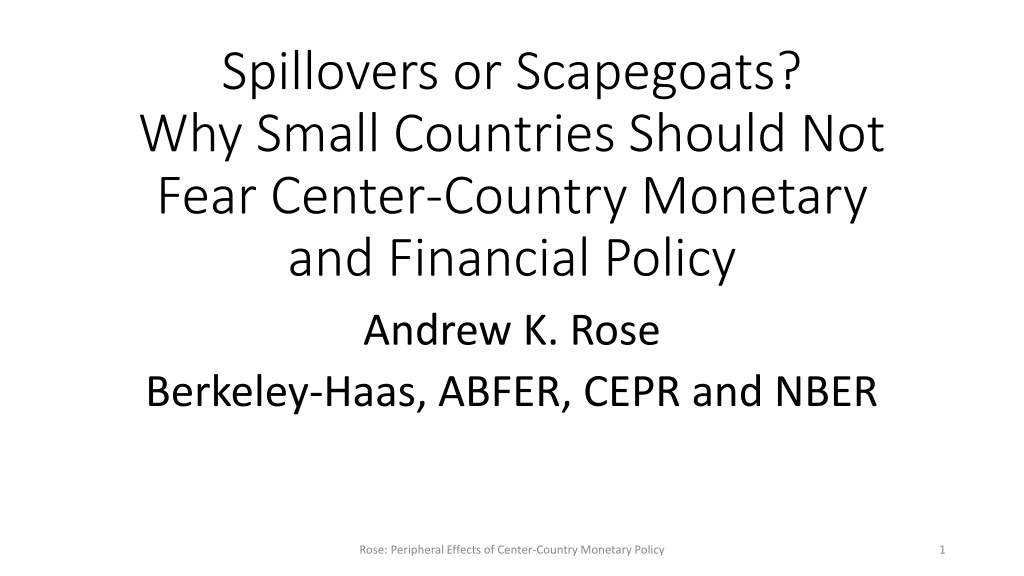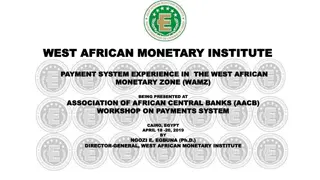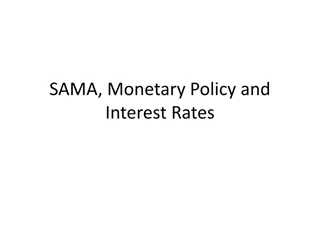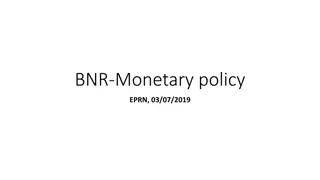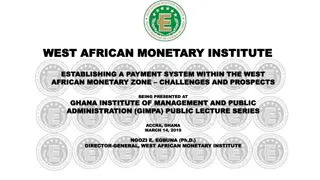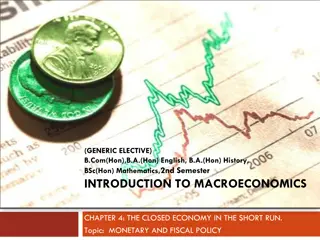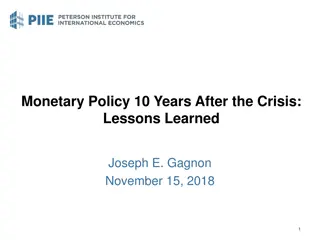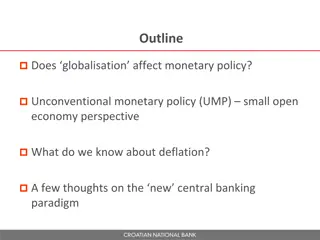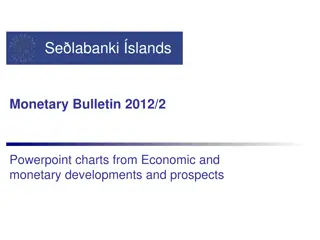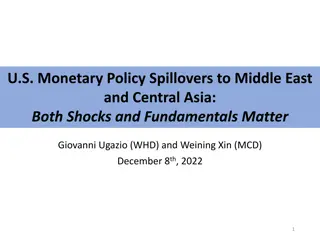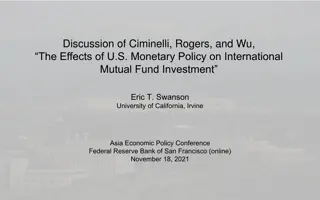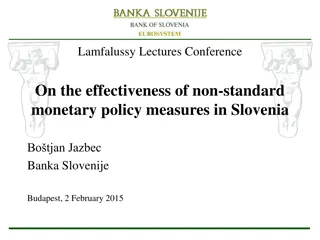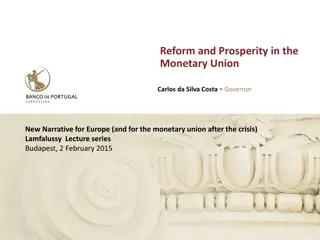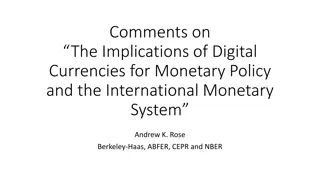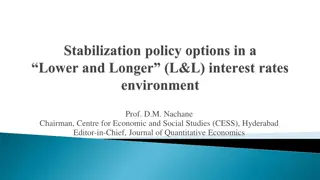Small Countries' Resilience Against Center-Country Monetary Policies
Small countries should not fear the monetary and financial policies of larger center countries. This article discusses the potential spillovers of unconventional monetary policies by center countries, such as quantitative easing and negative nominal interest rates. It explores the concept of currency wars and their impact on global trade, as well as the trade effects of unconventional central monetary policies. The evidence presented challenges the notion of currency wars being significantly detrimental and questions the importance of the global financial cycle for capital flows.
Download Presentation

Please find below an Image/Link to download the presentation.
The content on the website is provided AS IS for your information and personal use only. It may not be sold, licensed, or shared on other websites without obtaining consent from the author. Download presentation by click this link. If you encounter any issues during the download, it is possible that the publisher has removed the file from their server.
E N D
Presentation Transcript
Spillovers or Scapegoats? Why Small Countries Should Not Fear Center-Country Monetary and Financial Policy Andrew K. Rose Berkeley-Haas, ABFER, CEPR and NBER Rose: Peripheral Effects of Center-Country Monetary Policy 1
Two Approaches 1. Real Center countries engage in unconventional monetary policy Quantitative Easing, Negative Nominal Interest Rates, Forward Guidance ... Part of Motivation may be exchange rate depreciation Such beggar-thy-neighbor policies could raise center exports Is there evidence of Currency Wars ? Rose: Peripheral Effects of Center-Country Monetary Policy 2
Two Approaches, cont. 2. Financial (joint with Cerutti, Claessens) Center countries engage in (monetary) policy for domestic reasons This creates a global financial cycle (Rey) GFC spills over to developing countries and financial periphery in capital flows, asset prices, credit growth Rey: exchange rate regime has little effect (dilemma, not trilemma) Only capital controls provide insulation Is there evidence that GFC quantitatively important for capital flows? Rose: Peripheral Effects of Center-Country Monetary Policy 3
Trade Effects of Unconventional Central Monetary Policy: Motivation I heard two related complaints at international meetings and through the media: First, that the United States was engaging in currency wars a phrase used most prominently by Brazilian finance minister Guido Mantega in 2010, following the Fed s introduction of a second round of quantitative easing by choosing policies that would weaken the dollar and thereby unfairly increase US competitiveness at the expense of trading partners Currency wars is a colorful synonym for the familiar concept of competitive depreciation of exchange rates, with the goal of diverting world demand toward one s own exports while suppressing imports Bernanke (2015 Mundell-Fleming lecture) Rose: Peripheral Effects of Center-Country Monetary Policy 4
Quantitative Evidence? Little/No evidence in literature Three Currency Wars Characterizations/Assumptions 1. Result from Unconventional Monetary Policy (UMP) of Center Countries 2. Bilateral: involve economies engaged in UMP ( aggressors ) and those not ( victims ) The advanced countries are seeking to devalue their currencies in order to increase exports, naming the United States, Europe and Japan Mantega (2010) 3. If successful, should raise exports Rose: Peripheral Effects of Center-Country Monetary Policy 5
Nave Look at US Trade around QE American Trade around Quantitative Easing Rounds International Trade in Goods and Services, USD bn 600 500 Exports 400 300 QE1 QE2 QE3 2005q1 2008q1 2011q1 2014q1 2016q2 700 600 Imports 500 400 QE1 QE2 QE3 2005q1 2008q1 2011q1 2014q1 2016q2 Rose: Peripheral Effects of Center-Country Monetary Policy 6
No clear pattern Both exports, imports continue to drop after QE1 QE2 makes little difference QE3 followed by trade flattening But ... Superficial! Only one country examined Data multilateral (some US partners engaged in UMP) No attempt at ceteris paribus Rose: Peripheral Effects of Center-Country Monetary Policy 7
Easy to Correct with Gravity Model Plain vanilla LSDV technique (Head-Mayer): ln(Xijt) = UMPijt + Zijt + { it} + { jt} + { ij} + ijt Links exports (X) to controls (RTA, CU), time-varying exporter/importer fixed effects Long history of success as empirical model of trade Key coefficient ( ) on UMP dummy 1 if i has UMP and j does not, 0 ow Rose: Peripheral Effects of Center-Country Monetary Policy 8
Estimation Minutiae Conventional data sources Quarterly DoTS data 2000Q1-2016Q2, >200 countries, >1.3 million obs. Key to model: over 50,000 fixed effects Hold constant all dyadic time-invariant phenomena Language, distance, colonial history, common geography, Hold constant all country-specific phenomena Time-invariant (land area, sea access, ) Time-varying (business cycle, financial distress, protectionism, ) Rose: Peripheral Effects of Center-Country Monetary Policy 9
Notes Not estimating effect of (ex) QE1 on American exports All common monadic effects absorbed in FE Likely causes of UMP (stimulate insufficient American demand ) Rather: estimating additional effect of UMP by exporter on an importer not engaged in UMP is effect of current war by a particular belligerent on particular defenders, after sweeping out effect of war on belligerent. Rose: Peripheral Effects of Center-Country Monetary Policy 10
Unconventional Monetary Policy Measures Quantitative Easing 1 for any quarter where CB engages in balance sheet operations, 0 ow (flows) Variant with outstanding assets on balance sheet (stocks) Negative Nominal Interest Rates 1 for any quarter with negative market rates, 0 ow Variant uses official policy (not market) rates Data from central bank websites Rose: Peripheral Effects of Center-Country Monetary Policy 11
Unconventional Monetary Policy thru 2016Q2 Quantitative Easing Negative Nominal Interest Rates USA, QE1 USA, QE2 USA, QE3 UK, QE1 UK, QE2 UK, QE3 Switzerland Denmark Sweden Japan Japan EMU 2008Q4-2010Q1 2010Q4-2011Q2 2012Q3-2014Q4 2009Q1-2010Q1 2011Q4-2012Q2 2012Q3-2012Q4 2011Q3- 2012Q3- 2015Q1- 2015Q1- 2001Q1-2006Q1 2010Q4- 2015Q1- 2016Q1- 2014Q2- Rose: Peripheral Effects of Center-Country Monetary Policy 12
Results QE has small negative effect on exports, ceteris paribus Reduces exports 11% Statistically significant (|t statistic| >5) Ditto NNIR Can t reject hypothesis of equality (p-value .7) Reduces effect to 6% (No effect of state-contingent forward guidance) Rose: Peripheral Effects of Center-Country Monetary Policy 13
1 2 3 4 Exporter (not Imp) QE (2.4%) Exporter (not Imp) NNIR (2.5%) Currency Union RTA -.11** (.02) -.07** (.02) -.05* (.02) .32** (.02) .04** (.01) Yes -.09** (.02) .32** (.02) .04** (.01) Yes .35** (.02) .04** (.01) Yes .33** (.02) .04** (.01) Yes it (>11k) jt ( 13k) Yes Yes Yes Yes ij ( 26k) R2 RMSE Yes Yes Yes Yes .89 1.37 .89 1.37 .89 1.37 .89 1.37 Rose: Peripheral Effects of Center-Country Monetary Policy 14
Results Insensitive Quantitative Easing by Exporter, not Importer -.11** (.02) -.14** (.02) -.10** (.02) -.12** (.03) -.10** (.02) -.06** (.02) -.08** (.02) -.11** (.02) -.11** (.02) Neg. Nom. Int. Rate in Exporter, not Importer -.09** (.02) -.10** (.02) -.08** (.02) -.07** (.02) -.09** (.02) -.04* (.02) -.06** (.02) -.08** (.02) -.09** (.02) Test for Equality (p-value) .66 Default UMP Variants (Stock QE, Official NNIR) First lag of UMP .09 .59 Fourth lag of UMP .24 First lead of UMP .66 After 2011 .21 Before 2016 .71 Drop US as exporter Drop UK as exporter .57 .70 Rose: Peripheral Effects of Center-Country Monetary Policy 15
Quantitative Easing by Exporter, not Importer -.11** (.02) -.11** (.02) -.09** (.02) -.11** (.02) -.10** (.02) -.10** (.02) -.08* (.04) -.12** (.02) -.09** (.02) -.12** (.02) -.07** (.02) Neg. Nom. Int. Rate in Exporter, not Importer -.08** (.02) -.09** (.02) -.07** (.02) -.08** (.02) -.08** (.02) -.08** (.02) -.12** (.04) -.09** (.02) -.07** (.02) -.10** (.02) -.06** (.01) Test for Equality (p-value) .75 Drop Japan as exporter Drop Denmark as exporter Drop Sweden as exporter Drop Switzerland as exporter Drop Germany as exporter Drop China, HK as exporter Drop Advanced Countries as Importers Drop Asians DCs as importers Drop Africans as importers Drop Latin/Caribbean as importers Drop 3 outliers .50 .84 .16 .67 .58 .06 .51 .34 .87 >.99 Rose: Peripheral Effects of Center-Country Monetary Policy 16
Summary Evidence Quite Clear Any Currency Wars have been lost! Countries using Quantitative Easing and/or Negative Nominal Interest Rates have not experienced export booms Unanswered Question: Why do exports actually decline? Possibility: negative domestic productivity shocks lower exports, induce UMP, coincide with comparable positive foreign shocks Another: expectations of lower foreign demand? Awaits more research Rose: Peripheral Effects of Center-Country Monetary Policy 17
Next: Financial Effects of Central Monetary Policy because of Global Financial Cycle Risky asset prices around the globe, from stocks to corporate bonds, have a strong common component. So do capital flows Global financial cycles are associated with surges and retrenchments in capital flows, booms and busts in asset prices and crises. The picture emerging is that of a world with powerful global financial cycles characterized by large common movements in asset prices, gross flows, and leverage The global financial cycle can be related to monetary conditions in the centre country and to changes in risk aversion and uncertainty capital flows, especially credit flows, are largely driven by a global factor -- Rey at Jackson Hole (2013, pp 1-2) Rose: Peripheral Effects of Center-Country Monetary Policy 18
Motivation, continued Large gross cross-border flows are moving in tandem across countries regardless of the exchange rate regime, they tend to rise in periods of low volatility and risk aversion and decrease in periods of high volatility and risk aversion, as measured by the VIX There is a global financial cycle. -Passari and Rey (2015, p 693) Also, work by Forbes and Warnock, Bruno and Shin, Ghosh et al Rose: Peripheral Effects of Center-Country Monetary Policy 19
The GFCycle Should Matter for Small Countries, especially Emerging Markets If GFCycle explains most variation in capital flows, then Difficult for policy-makers to do much more than insulate economies with capital controls, macro-prudential instruments and the like As capital flows respond to US monetary policy, they may not be appropriate for the cyclical conditions of many economies. For some countries, the Global Financial Cycle can lead to excessive credit growth in boom times and excessive retrenchment in bad times. The Global Financial Cycle can be associated with surges and dry outs in capital flows, booms and busts in asset prices and crises -- Rey (2015, pp 9-10) Rose: Peripheral Effects of Center-Country Monetary Policy 20
But Suppose GFCycle is not that important Onus shifts back from the center Responsibility for creating and handling capital flows is properly domain of the policy authorities in small and/or poor countries. Inappropriate for policy-makers in emerging markets to blame America for their domestic woes if American financial shocks simply do not explain many fluctuations in capital flows and the like. Rose: Peripheral Effects of Center-Country Monetary Policy 21
So How Important is the Global Financial Cycle? Literature leads one to believe: VERY! But informal (interpretations of plots) Here: focus on quantifying the importance of GFCycle for capital flows GFCycle, if significant, should be manifest in strong commonality of capital flows Hence use dynamic factor model to extract common factor (from biggest eigenvalue) Rose: Peripheral Effects of Center-Country Monetary Policy 22
Measuring Global Financial Cycle via Observable Fundamentals VIX: Consensus Measurable Fundamental of Global Financial Cycle USA typically viewed as center-country, but perhaps EMU? UK? Other measures of Uncertainty/Fear (VDAX/VSTOXX/IVI)? Other fundamentals (nominal and ex post real interest rates, TED spread, yield curve slope, GDP growth, M2 growth) Rose: Peripheral Effects of Center-Country Monetary Policy 23
VIX standard in literature Passari and Rey (2015): VIX is our proxy for the global financial cycle Large gross cross-border flows are moving in tandem across countries regardless of the exchange rate regime, they tend to rise in periods of low volatility and risk aversion and decrease in periods of high volatility and risk aversion, as measured by the VIX Rey (2013): There is a global financial cycle in capital flows, asset process, and in credit growth. This cycle co-moves with the VIX, a measure of uncertainty and risk aversion of the markets. VIX used by: Advjiev et al. (2016); Bruno and Shin (2015a, b); Cerutti et al. (2014); Fratzscher (2012) Forbes and Warnock (2012) use closely correlated predecessor (VXO) Rose: Peripheral Effects of Center-Country Monetary Policy 24
VIX: uncorrelated with raw capital flows Capital Flows and the VIX Capital Flows, %GDP (y) against VIX (x); 63 small countries 1990Q1-2015Q4 FDI Inflows Debt Inflows Equity Inflows Credit Inflows Corr=.02 Corr=-.09 Corr=-.03 Corr=0.05 100 200 100 150 200 600 400 100 50 0 200 0 -200 -100 0 -100 0 -50 10 20 30 40 50 10 20 30 40 50 10 20 30 40 50 10 20 30 40 50 FDI Outflows Debt Outflows Equity Outflows Credit Outflows Corr=.01 Corr=-.05 Corr=-.00 Corr=-.06 100 100 200 300 200 200 400 600 100 50 0 0 0 0 -100 -50 -200 -100 10 20 30 40 50 10 20 30 40 50 10 20 30 40 50 10 20 30 40 50 Rose: Peripheral Effects of Center-Country Monetary Policy 25
Ditto with Dynamic Capital Flow Factors (And Different Types of Capital Flows Little Correlated) Capital Flow Factors and the VIX Dynamic factors (1 lag) 1990Q1-2015Q4, Advanced Economies Date 40 30 VIX 20 10 5 FDI inflows 0 -5 10 Debt inflows 5 0 1 Equity inflows 0 -1 2 Credit inflows 1 0 5 FDI 0 outflows -5 5 Debt outflows 0 -5 4 Equity outflows 2 0 -2 10 Credit outflows 5 0 1990q1 2008q3 10 20 30 40 -5 0 5 0 5 10 -1 0 1 0 1 2 -5 0 5 -5 0 5 -2 0 2 4 Rose: Peripheral Effects of Center-Country Monetary Policy 26
Do Center-Country Fundamentals Drive Capital Flows? Investigate by estimating (a slew of) national capital flow equations: CAPFLOWd,e,i,t= ijUSFUNDjt + kFACd,ekt + i + d,e,i,t across t CAPFLOWd,e,i,t is capital flow direction d, type e, country i, quarter t USFUNDit are 8 US fundamentals indexed by j 1) VIX; 2) nominal policy interest rate; 3) ex post real rate; 4) TED spread (3m LIBOR-gov t); 5) yield curve slope (10y-3m gov t rate); 6) GDP growth; 7) M2 growth); 8) change in REER (CPI). FAC are factors (matched to d,e) for advanced and emerging countries Rose: Peripheral Effects of Center-Country Monetary Policy 27
Many Equations, hence Many Estimates! Estimate a t/s capital flow equation for each direction/type/country 2 directions (in/out), 4 types (FDI, equity, debt, bank credit), 63 countries So hundreds of equations Analyze histograms of goodness of fit for each equation 2 to provide familiar statistic, (modest) over-fitting penalty Use R Histograms indicated generically poor fit Rose: Peripheral Effects of Center-Country Monetary Policy 28
Fit of Country Time-Series Capital Flow Regressions 2s, small countries 1990Q1-2015Q4 Histograms of (up to 598) adjusted R All Inflows Outflows All Portfolio Mean=.12 Mean=.14 Mean=.10 Mean=.11 4 4 4 3 4 3 3 3 2 2 2 1 2 1 1 1 0 0 0 0 -.2 0 .25 .5 1 -.2 0 .25 .5 1 -.2 0 .25 .5 1 -.2 0 .25 .5 1 FDI Inflows Debt Inflows Equity Inflows Credit Inflows Mean=.25 Mean=.09 Mean=.12 Mean=.13 3 0 1 2 3 4 5 4 4 3 3 2 2 2 1 1 1 0 0 0 -.2 0 .25 .5 1 -.2 0 .25 .5 1 -.2 0 .25 .5 1 -.2 0 .25 .5 1 FDI Outflows Debt Outflows Equity Outflows Credit Outflows Mean=.14 Mean=.10 Mean=.14 Mean=.02 0 1 2 3 4 5 8 3 3 6 2 2 4 1 1 2 0 0 0 -.2 0 .25 .5 1 -.2 0 .25 .5 1 -.2 0 .25 .5 1 -.2 0 .25 .5 1 Regressors: Adv/EM 26-yr dyn factors, 8 US var's (VIX/TED/yield/policy/real/growth/REER chg/M2 growth) Rose: Peripheral Effects of Center-Country Monetary Policy 29
Box Plots: Same Information, More Efficient 2 portrayed with horizontal box plots Distribution of R Box: 25th to 75th percentiles Median marked by a vertical bar Whiskers extend out to adjacent values Defined as most extreme values within 150% of the interquartile range of nearest quartile Outliers individually marked Note vertical line at .25! Rose: Peripheral Effects of Center-Country Monetary Policy 30
Fit of Country Time-Series Capital Flow Regressions 2s, Different Samples/Specifications Box-Plots of Adjusted/Raw R Adj R2, any data Adj R2, all 26 years Adj R2, no US Vars FDI FDI FDI Debt Debt Debt Inflow Inflow Inflow Equity Equity Equity Credit Credit Credit FDI FDI FDI Debt Debt Debt Outflow Outflow Outflow Equity Equity Equity Credit Credit Credit -.250 .25 .5 .75 1 -.25 0 .25 .5 .75 1 -.25 0 .25 .5 .75 1 Raw R2, any data Raw R2, all 26 years Raw R2, no US Vars FDI FDI FDI Debt Debt Debt Inflow Inflow Inflow Equity Equity Equity Credit Credit Credit FDI FDI FDI Debt Debt Debt Outflow Outflow Outflow Equity Equity Equity Credit Credit Credit 0 .25 .5 .75 1 0 .25 .5 .75 1 0 .25 .5 .75 1 8 contemporary US vars, Adv + EM 26-yr dynamic factors, intercept; small countries 1990Q1-2015Q4 Rose: Peripheral Effects of Center-Country Monetary Policy 31
Easy to Establish Robustness Rose: Peripheral Effects of Center-Country Monetary Policy 32
Fit of Country Time-Series Capital Flow Regressions 2s, Different Samples/Specifications Box-Plots of Adjusted R Drop Dynamic Factors Substitute Static Factors Substitute MAR Factors FDI FDI FDI Debt Debt Debt Inflow Inflow Inflow Equity Equity Equity Credit Credit Credit FDI FDI FDI Debt Debt Debt Outflow Outflow Outflow Equity Equity Equity Credit Credit Credit -.25 0 .25 .5 .75 1 -.25 0 .25 .5 .75 1 -.5-.25 0 .25 .5 .75 1 Add 4 lags of the VIX Add 1 lag of all US vars Add EMU UK fund vars FDI FDI FDI Debt Debt Debt Inflow Inflow Inflow Equity Equity Equity Credit Credit Credit FDI FDI FDI Debt Debt Debt Outflow Outflow Outflow Equity Equity Equity Credit Credit Credit -.25 0 .25 .5 .75 1 -.25 0 .25 .5 .75 1 -.5-.250 .25 .5 .75 1 Default: 8 US vars, Adv/EM 26-yr dynamic factors, intercept; small countries 1990Q1-2015Q4 Rose: Peripheral Effects of Center-Country Monetary Policy 33
Fit of Country Time-Series Capital Flow Regressions 2s, Different Samples Box-Plots of Adjusted R 2009 Coefficient Break Drop >8% obs Drop Advanced FDI FDI FDI Debt Debt Debt Inflow Inflow Inflow Equity Equity Equity Credit Credit Credit FDI FDI FDI Debt Debt Debt Outflow Outflow Outflow Equity Equity Equity Credit Credit Credit -.5-.250 .25 .5.75 1 -.250 .25 .5 .75 1 -.250 .25 .5 .75 1 5% Winsorized Drop 1990-1995 Drop >|2.5 | Residuals FDI FDI FDI Debt Debt Debt Inflow Inflow Inflow Equity Equity Equity Credit Credit Credit FDI FDI FDI Debt Debt Debt Outflow Outflow Outflow Equity Equity Equity Credit Credit Credit -.5-.250 .25 .5 .75 1 -.250 .25 .5 .75 1 -.250 .25 .5 .75 1 8 contemporary US vars, Adv + EM 26-yr dynamic factors, intercept; small countries 1990Q1-2015Q4 Rose: Peripheral Effects of Center-Country Monetary Policy 34
Fit of Country Time-Series Capital Flow Regressions 2s, Different Samples Box-Plots of Adjusted R Drop low Capital Mobility East/Cen Asia, Pac, Europe Band/Floating Exchange Rate FDI FDI FDI Debt Debt Debt Inflow Inflow Inflow Equity Equity Equity Credit Credit Credit FDI FDI FDI Debt Debt Debt Outflow Outflow Outflow Equity Equity Equity Credit Credit Credit -.25 0 .25 .5 .75 1 -.25 0 .25 .5 .75 1 -.5-.25 0 .25 .5 .75 1 Drop GDP per capita<$5k Drop E/C Asia, Pac & Eur Currency Union/Board/Peg FDI FDI FDI Debt Debt Debt Inflow Inflow Inflow Equity Equity Equity Credit Credit Credit FDI FDI FDI Debt Debt Debt Outflow Outflow Outflow Equity Equity Equity Credit Credit Credit -.25 0 .25 .5 .75 1 -.25 0 .25 .5 .75 1 -.5-.25 0 .25 .5 .75 1 8 contemporary US vars, Adv + EM 26-yr dynamic factors, intercept; small countries 1990Q1-2015Q4 Rose: Peripheral Effects of Center-Country Monetary Policy 35
Perhaps GFCycle a Crisis (not Tranquility) Phenomenon? Examine capital flows during periods of crisis Define crisis as high VIX values No indication of systematic movement around crises Sensitivity analysis indicates robustness Rose: Peripheral Effects of Center-Country Monetary Policy 36
Capital Flows (%GDP) around quarters when VIX close>30 FDI Inflows Debt Inflows Equity Inflows Credit Inflows 20 10 20 4 15 10 5 2 10 5 0 0 0 0 -10 -2 -5 -5 -12 0 12 -12 0 12 -12 0 12 -12 0 12 FDI Outflows Debt Outflows Equity Outflows Credit Outflows 15 10 15 8 10 6 10 5 4 5 5 2 0 0 0 0 -5 -2 -10 -5 -5 -12 0 12 -12 0 12 -12 0 12 -12 0 12 Means with (5,95) confidence interval. 1990Q1-2015Q4 data, 63 small countries. Rose: Peripheral Effects of Center-Country Monetary Policy 37
GFCycle: Summary Hard to find GFCycle! VIX (and other fundamentals) not correlated with capital flows Capital flows have very limited comovement! Capital flows not much driven by center-country phenomena or commonality embedded in capital flows GFCycle rarely explains 25% of capital flows So small economies can t blame vagaries of GFCycle (US monetary policy?) for capital flows Rose: Peripheral Effects of Center-Country Monetary Policy 38
Conclusion Fed/Northern monetary policy a convenient scape-goat Easier to blame outsiders for domestic woes But little evidence that woes of EMs due to Northern monetary policy Southern exports grew during periods of unconventional monetary policy No sign that capital flows much affected by GFCycle GFCycle hard to detect! Odd for supposedly pervasive common element Responsibility for troubles in EMs does not lie in Washington! Rose: Peripheral Effects of Center-Country Monetary Policy 39
